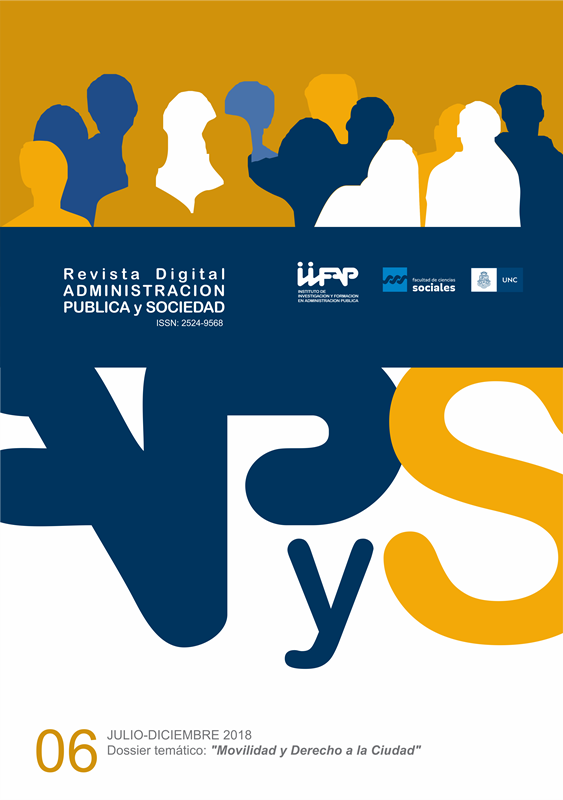Movilidad urbana sustentable: Algunos principios básicos y soluciones
Contenido principal del artículo
Resumen
Detalles del artículo
Sección
- Los autores/as conservarán sus derechos de autor (esto incluye el copyrigth) y garantizarán a la revista el derecho de primera publicación de su obra, el cuál estará simultáneamente sujeto a la Licencia de reconocimiento de Creative Commons: No se permite un uso comercial de la obra original ni de las posibles obras derivadas, la distribución de las cuales se debe hacer con una licencia igual a la que regula la obra original.
- Los autores/as podrán adoptar otros acuerdos de licencia no exclusiva de distribución de la versión de la obra publicada (p. ej.: situarlo en un repositorio institucional o publicarla en un libro) siempre que se indique la publicación inicial en esta revista.
- Se permite y recomienda a los autores/as difundir su obra a través de Internet (p. ej.: en repositorios institucionales o en su página web) luego del proceso de publicación, lo cual puede producir intercambios interesantes y aumentar las citas de la obra publicada. (Véase El efecto del acceso abierto).
Cómo citar
Referencias
Ampt, E.S. y Ortúzar, J. de D. (2004) On best practice in continuous large-scale mobility surveys. Transport Reviews 24, 337-363.
Basso, L.J., Silva, H.E. y Riquelme, I. (2017) Urban road congestion management: capacity investments and pricing policies. 13th International Conference of The Western Economic Association International, 3-6 Junio, Pontificia Universidad Católica de Chile, Santiago.
Burford, G., Hoover, E., Velasco, I., Janoušková, S., Jimenez, A., Piggot, G., Podger, D. y Harder, M.K. (2013) Bringing the “missing pillar” into sustainable development goals: towards intersubjective values-based indicators sustainability. Sustainability 5, 3035-3059.
Braess, D., Nagurney, A. y Wakolbinger, T. (2005) On a paradox of traffic planning. Transportation Science 39, 446–450.
Campoli, J. (2012) Made for Walking: Density and Neighbourhood Form. Lincoln Institute of Land Policy, Washington, D.C.
Cantillo, V. y Ortúzar, J. de D. (2014) Restricting the use of cars by license plate numbers: a misguided urban transport policy. Dyna 81, 75-82.
CEDEUS (2017) Centro de Desarrollo Urbano Sustentable (www.cedeus.cl), Santiago.
CEDEUS-MINVU (2018) Sustentabilidad a Escala de Barrio. Re-visitando el programa “Quiero mi Barrio”. Ministerio de Vivienda y Urbanismo, Santiago.
Cervero, R. y Kockelman, K. (1997) Travel demand and the 3Ds: density, diversity and design. Transportation Research Part D: Transport and Environment 2, 199-219.
De Lisio, A. (1999) Desarrollo sustentable: opciones y limitaciones para América Latina y el Caribe. Revista Cuadernos del Cendes 16, 1-23.
Downs, A. (1962) The law of peak-hour expressway congestion. Traffic Quarterly 16, 393–409.
Harding. T. (2014) Common Sense Fallacy.(https://yandoo.wordpress.com/2014/12/28/common-sense-fallacy/).
Hensher, D.A. y Bliemer, M. (2014) What type of road pricing scheme might appeal to politicians? Viewpoints on the challenge in gaining the citizen and public servant vote by staging reform. Transportation Research Part A: Policy and Practice 61, 227-237.
Informe Brundtlandt (1987) Nuestro Futuro Común. Comisión Mundial para el Medio Ambiente y el Desarrollo, ONU, Washington, D.C.
International Union for Conservation of Nature and Natural Resources (1980) World Conservation Strategy: Living Resource Conservation for Sustainable Development. ONU, Gland, Suiza.
Jacobs, J. (1961) The Death and Life of Great American Cities. Random House, Nueva York.
Kimber, R.M, McDonald, M. y Hounsell, N. (1985) Passenger car units in saturation flows: concept, definition, derivation. Transportation Research Part B: Methodological 19, 39-61.
Littig, B. y Griessler, E. (2005) Social sustainability: a catchword between political pragmatism and social theory. International Journal of Sustainable Development 8, 65-79.
Miller, E. (2018) Viewpoint: integrated urban modelling- past, present and future. The Journal of Transport and Land Use 11, 387-399.
Mogridge, M.J.H. (1990) Planning for optimum urban efficiency: the relationship between congestion on the roads and public transport. Transportation Planning Systems 11–19.
Mogridge, M.J.H., Holden, D.J., Bird, J. y Terzis, G.C. (1987) The Downs-Thomson paradox and the transportation planning process. International Journal of Transport Economics 14, 283-311.
Ortúzar, J. de D., Bascuñán, R., Salata, A. y Rizzi, L.I (2018) Assessing the potential acceptability of road pricing in Santiago. Transportation Research Part A: Policy and Practice (en revision).
Ortúzar, J. de D. y Willumsen, L.G. (2011) Modelling Transport. John Wiley and Sons, Chichester.
Rittel, H.W.J y Webber, M.M. (1973) Dilemmas in a general theory of planning. Policy Sciences 4, 155-169.
Rizzi, L.I. y de la Maza, C. (2017) The external costs of private versus public road transport in the Metropolitan Area of Santiago, Chile. Transportation Research Part A: Policy and Practice 98, 123-140.
Schrank, D., Eisele, B., Lomax, T. y Bak, J. (2015) 2015 Urban Mobility Scorecard. The Texas A&M Transportation Institute, College Station, TX.
Smart Growth America (2015) Safer Streets, Stronger Economies: Complete Street Project Outcomes from Across the Country. Smart Growth America, Washington, D.C.
Spangenberg, J.H., Omann, I. y Hinterberger, F. (2002) Sustainable growth criteria. minimum benchmarks and scenarios for employment and the environment. Ecological Economics 42, 429- 443.
Thomson, J.M. (1977) Great Cities and Their Traffic. Gollancz, Peregrine Edition, Londres.
Wilson, P. (2015) Urban Sustainability Theory and Practice. Routledge, Londres.

